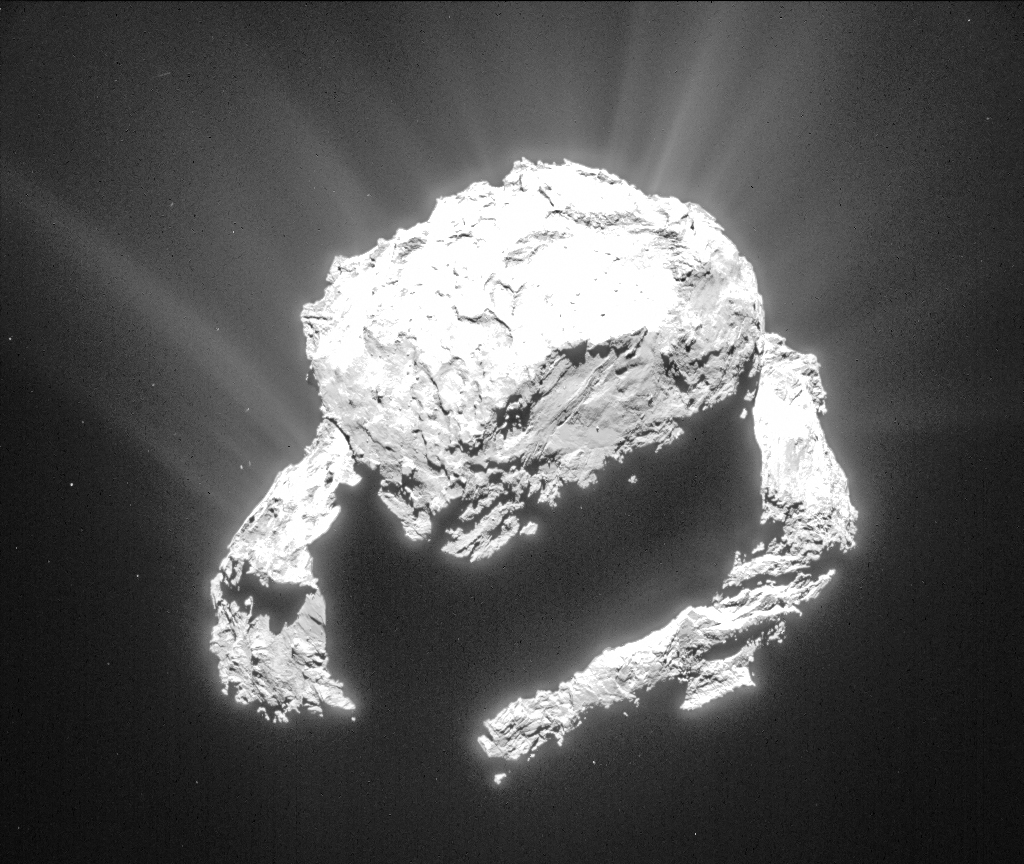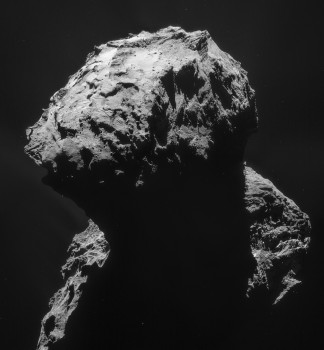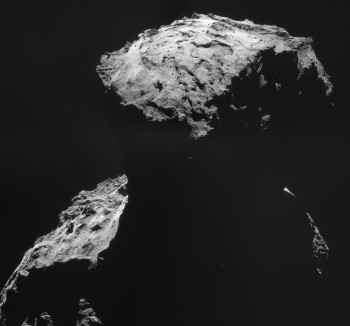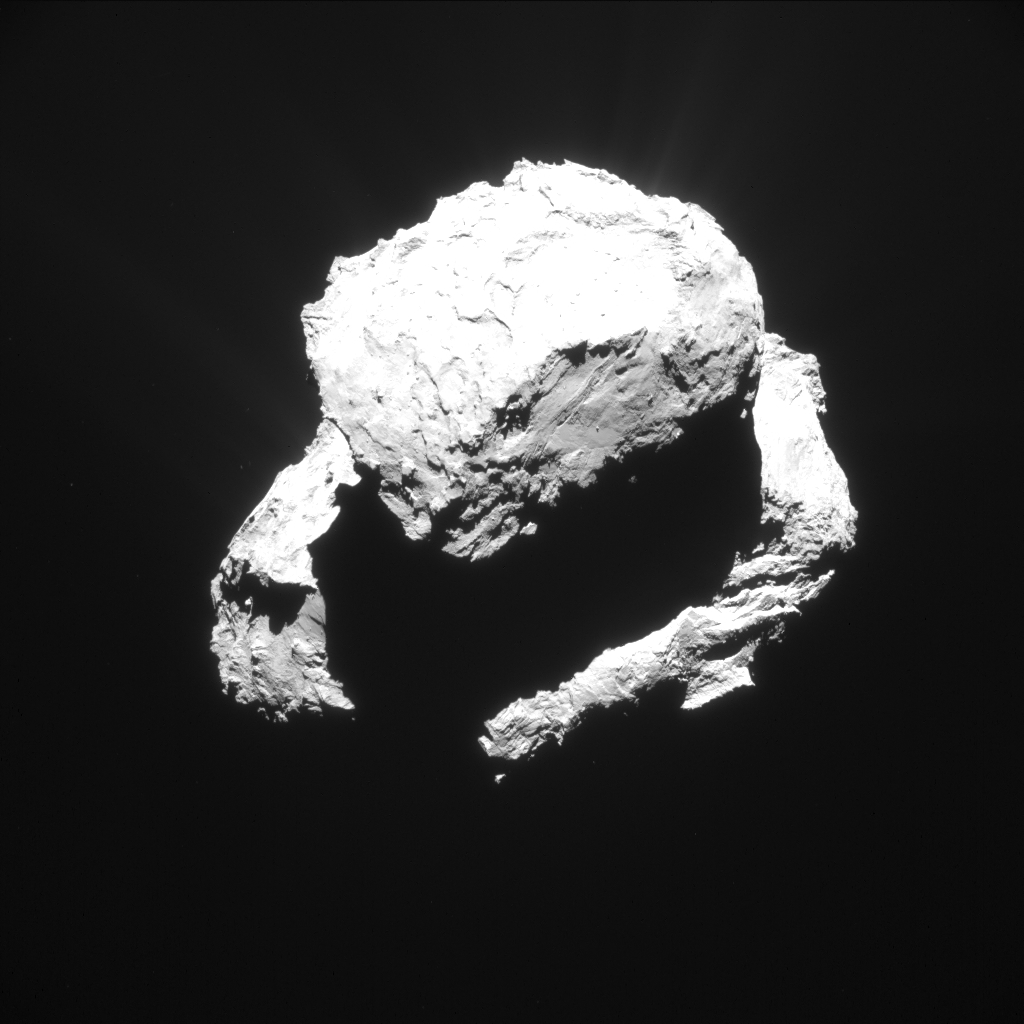Today’s CometWatch entry was captured on 9 March at a distance of 71.9 km from the centre of Comet 67P/Churyumov-Gerasimenko.

Cropped and processed single frame NAVCAM image of Comet 67P/C-G taken 9 March from a distance of 71.9 km to the comet centre. Credits: ESA/Rosetta/NAVCAM – CC BY-SA IGO 3.0

Four image mosaic comprising images taken on 18 January 2015 Credits: ESA/Rosetta/NAVCAM – CC BY-SA IGO 3.0
The scale is 6.1 m/pixel and the image measures 6.3 km across (note that the processed version above is slightly cropped in the vertical direction for aesthetic purposes; the original provided at the end of the post is uncropped). As with recent previous entries, these Alice context images are currently slightly over-exposed on some parts of the comet, so we have pushed the contrast to focus on the activity of the comet. Indeed, many jets can be seen against the dark backdrop.
But, at the same time, this view provides one of the clearest views yet of a region on the small comet lobe that in many previously published images has been partly cast in shadow. Thus, included in this post for comparison is roughly the same region seen at different angles/illumination conditions on 30 October 2014 and 18 January 2015.
The region also includes the Philae “search area” – see the context image here for reference.
The original 1024 x 1024 pixel frame for today’s CometWatch entry is provided below:











Discussion: 14 comments
The head lobe looks as if it’s been sliced through with a knife. You can see the exposed strata layers crossing, and sloping up a little, from left to right. You can trace these round the ‘corner’ of the head to the undamaged part, where they continue right round the other side of the lobe. These strata are shown very clearly in this photo from Cometwatch 19th August 2014:
https://blogs.esa.int/rosetta/2014/08/20/cometwatch-19-august/
You can also see them turning sharply and spectacularly round the same ‘corner’ in this image from Cometwatch 31st January 2015 (extreme right of frame):
https://blogs.esa.int/rosetta/2015/02/06/anuket-vs-anubis-cometwatch-31-january/
This sharp corner and the comparatively flat face left behind show that these strata have almost certainly been sheared away and lost to deep space. Before this event, the head lobe would have been rounded on this side, just like it is on the other side.
This extensive damage is expected in stretch theory: the head lobe tipped forward in line with the rotation plane when it sheared around its sides and back end. As it began to tip, the back and sides lifted cleanly but the ‘nose’ ground into the body before lifting off. This caused the strata on this side to be pushed violently upwards, snapping each and every one of them. It also explains the resulting ragged remains on the body.
This link explains the mechanism of tip and lift and describes the front of the neck as the fulcrum on which the nose was swivelling.
https://scute1133site.wordpress.com/2015/01/19/67p-churyumov-gerasimenko-a-single-body-thats-been-stretched-part-10/
Beautiful. So looking forward to Philae waking up.
Just a fantastic image again Emily, Thank You. Another viewpoint, another totally different appearance. The head appears to have been sharpened to a point, the corners of the head having been sheared off. One can only think this is some effect of the shadow from the body lobe during the weeks of maximum erosion around Perihelion.
So we get a look at the whole possible landing area for Philae in this image. There are still a few shadows and the resolution is clearly not going to facilitate an identification of Philae, however the more important point is how much light is now reaching the area. Both the images are overexposed, but it is clear that Philae’s little alcove is receiving good amounts of light, how much is reaching her solar panels is a different matter. After a little tweaking I managed to pick out Philae’s little hiding hole, not easy, because it is not a dark crevice in this image.
https://www.flickr.com/photos/124013840@N06/16779824616/in/photostream/
I have marked the approximate first touchdown as well, but with most of the landmarks bleached out it is not exact. The green circle contains the alcove where Philae is hiding and even on this zoomed and slightly upscaled image it is difficult to see much. On seeing that the illumination levels were so high I figured Philae’s high albedo might make here appear a lot bigger than she actually is, so I pushed the boat out and really cranked up the zoom and upscaling, and this is what I got.
https://www.flickr.com/photos/124013840@N06/16186180293/in/photostream/
With lots of wishful thinking I could say the triangular blob is Philae, but its clearly not admissible as any type of identification evidence. The description outlines some slightly less dubious conclusions. If it is Philae though, she sure is shining brightly, which would be good news.
Disco ball smoke machine combo
This image provides a clear shot of the near-surface, diffuse layer of dust separate from the jets. In reality, this structure is the Langmuir sheath, produced as the charged body travels through a plasma environment of a different net charge.
Here comes The Sun!!
Along with the blog post OSIRIS DETECTS HINTS OF ICE IN COMET’S NECK
https://blogs.esa.int/rosetta/2015/03/13/osiris-detects-hints-of-ice-in-comets-neck/
thank you very much Emily & all at Blog team for giving me an idea that it must be more exciting than I had imagined, to watch how both Southern regions that have been in the shadow for past long months (years?) & Northern hemi-duck will behave in coming months as the comet orbits towards perihelion!!
Looking forward to CometWatch/NAVCAM images as always, to experience it in near-realtime!!
Well, at least it looks as if the lander search area is well exposed to sunlight now.
I really hope Philae wakes up. It would be great having observations from the surface…. Fingers crossed. 🙂
Good Work Robin Sherman! The areas you marked out are really good candidates for finding the lander. However I wonder if the processing done of the image might be exaggerating the sunlight falling on that area.
Dear Robin Sherman,
your speculations about the position of Philea become more and more ridiculous. Did you notice the scale of the image? It is 6.1 m per pixel. That means, Philae in this picuture is about 0.16 pixels wide. Even if you take a high albedo and a lot of diffuse scattering into account, and thus assume that Philae affects a projected area of, generously say, 10 by 10 meters, even then it still would cover much less than a single pixel.
The “triangular blob” you are putting a label on is about 6 pixels across, that is about 36 meters. Philae would fit almost 1300 times into that area!
So, my advice is – please be patient and wait for more suitable images to come. Eventually ESA will find Philae, and certainly the readers of this blog will appreciate and credit your early thoughts about the final landing site.
HI, Michael Feuerbacher. There are people around here -neophyte to science- asking if there is energy in the shadows, and nobody is guiding them. What’s wrong with being ridiculous? Or speculating? Aren’t you?
Your answer looks reasonable. Any reason for the pondering? Robin has been contributing a lot of disciplined and acute observations -and speculations- we are chewing on.
What’s wrong with having an extra pair of wine glasses late, late on Friday? Or even a full bottle?
Cheers, Michael.
Michael: What do you think happened when the Hubble telescope saw a white spot on Ceres?
Can’t avoid to comment that ‘diva’ pose 😉
Are the lights at the right angle?
Logan: Look at all the dust being removed by the soap being advertised.